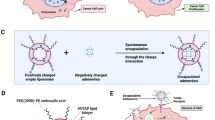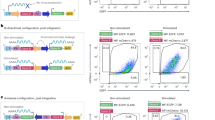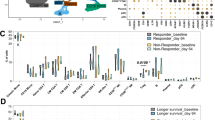Abstract
The host-immune response against adenoviruses forms a major obstacle for their use as gene therapy vectors for treatment of genetic defects. None the less, they are the preferred vectors for in vivo gene transfer in experimental gene therapy protocols for cancer. In this article we demonstrate the antitumor efficacy of adenovirus-mediated transfer of human interleukin-2 cDNA in the rat-CC531 model for hepatic metastases of colorectal cancer: intratumoral administration of 108 plaque-forming units of the hIL-2-expressing adenoviral vector, AdCAIL-2, resulted in a cessation of tumor growth in 80% of the injected tumors. In control groups receiving AdCnull, a vector with the same viral backbone, but lacking transgene expression, none of the tumors responded. However, intratumoral treatment with this vector significantly enhanced tumor regression induced by systemic IL-2 protein treatment, which was used as a positive control. In addition we show, by performing delayed-type of hypersensitivity assays, that AdCnull when injected intratumorally enhances recognition of tumor antigens by T lymphocytes to the same extent as intratumoral treatment with the IL-2-expressing vector. The replication-deficient adenoviruses appear to have a therapeutic advantage in cytokine-mediated immunotherapy: even adenovirus vectors that do not express a transgene, show adjuvant activity and stimulate an antitumor immune response.
This is a preview of subscription content, access via your institution
Access options
Subscribe to this journal
Receive 6 print issues and online access
$259.00 per year
only $43.17 per issue
Buy this article
- Purchase on SpringerLink
- Instant access to full article PDF
Prices may be subject to local taxes which are calculated during checkout



Similar content being viewed by others
References
Vlk V et al. Interleukin-2 gene therapy of surgical minimal residual tumor disease Int J Cancer 1998 76: 115–119
Robinson BWS et al. Cytokine gene therapy or infusion as treatment for solid human cancer J Immunol Ther 1998 21: 211–217
Porgador A et al. Anti-metastatic vaccination of tumor-bearing mice with IL-2-gene-inserted tumor cells Int J Cancer 1993 53: 471–477
Addison CL et al. Intratumoral injection of an adenovirus expressing interleukin-2 induces regression and immunity in a murine breast cancer model Proc Natl Acad Sci USA 1995 92: 8522–8526
Abdel-Wahab Z et al. Eradication of melanoma pulmonary metastases by immunotherapy with tumor cells engineered to secrete interleukin-2 or gamma-interferon Cancer Gene Ther 1997 4: 33–41
Zhang R, Straus FH, De Groot LJ . Effective genetic therapy of established medullary thyroid carcinomas with murine interleukin-2: dissemination and cytotoxicity studies in a rat tumor model Endocrinology 1999 140: 2152–2158
Tsai SC et al. Induction of antitumor immunity by interleukin-2 gene-transduced mouse mammary tumor cells versus transduced mammary stromal fibroblasts J Natl Cancer Inst 1993 85: 546–553
Fearon ER et al. Interleukin-2 production by tumor cells bypasses T helper function in the generation of an antitumor response Cell 1990 60: 397–403
Bukowski RM . Natural history and therapy of metastatic renal cell carcinoma, The role of interleukin-2 Cancer 1997 80: 1198–1220
Anderson TD, Hayes TJ . Toxicity of human recombinant interleukin-2 in rats. Pathologic changes are characterized by marked lymphocytic and eosinophilic proliferation and multisystem involvement Lab Invest 1989 60: 331–346
Siegel JP, Puri RK . Interleukin-2 toxicity J Clin Oncol 1991 9: 694–704
Bui LA et al. In vivo therapy of hepatocellular carcinoma with a tumor-specific adenoviral vector expressing interleukin-2 Hum Gene Ther 1997 8: 2173–2182
Pützer BM et al. Combination therapy with interleukin-2 and wild-type p53 expressed by adenoviral vectors potentiates tumor regression in a murine model of breast cancer Hum Gene Ther 1998 9: 707–718
Chen SH et al. Combination gene therapy for liver metastasis of colon carcinoma in vivo Proc Natl Acad Sci USA 1995 92: 2577–2581
Coll JL et al. Long-term survival of immunocompetent rats with intraperitoneal colon carcinoma tumors using herpes simplex thymidine kinase/ganciclovir and IL-2 treatments Gene Therapy 1997 4: 1160–1166
Emtage PC et al. A double recombinant adenovirus expressing the costimulatory molecule B7–1 (murine) and human IL-2 induces complete tumor regression in a murine breast adenocarcinoma model J Immunol 1998 160: 2531–2538
Addison CL et al. Intratumoral coinjection of adenoviral vectors expressing IL-2 and IL-12 results in enhanced frequency of regression of injected and untreated distal tumors Gene Therapy 1998 5: 1400–1409
Parkinson DR . Interleukin-2 in cancer therapy Semin Oncol 1988 15: 10–26
Ferrini S, Melioli G, Moretta L . Immunotherapy and immunity to cancer: cellular mechanisms Curr Opin Immunol 1990 2: 683–688
DeMatteo RP et al. Cellular immunity delimits adenoviral gene therapy strategies for the treatment of neoplastic diseases Ann Surg Oncol 1999 6: 88–94
Yang Y et al. Immune responses to viral antigens versus transgene product in the elimination of recombinant adenovirus-infected hepatocytes in vivo Gene Therapy 1996 3: 137–144
Van der Eb MM et al. Severe hepatic dysfunction after adenovirus-mediated transfer of the herpes simplex virus thymidine kinase gene and ganciclovir administration Gene Therapy 1998 5: 451–458
Hagenaars M et al. Regional administration of natural killer cells in a rat hepatic metastasis model results in better tumor infiltration and anti-tumor response than systemic administration Int J Cancer 1998 75: 233–238
Essery G, Feldmann M, Lamb JR . Interleukin-2 can prevent and reverse antigen-induced unresponsiveness in cloned human T lymphocytes Immunology 1988 64: 413–417
Waanders GA et al. Melanoma-reactive human cytotoxic T lymphocytes derived from skin biopsies of delayed-type hypersensitivity reactions induced by injection of an autologous melanoma cell line Clin Cancer Res 1997 3: 685–696
Fox BA et al. Lipofection indirectly increases expression of endogenous major histocompatibility complex class I molecules on tumor cells Cancer Gene Ther 1998 5: 307–312
Rea DG et al. Adenoviruses activate human dendritic cells without polarization towards a T helper type 1-inducing subset J Virol 1999 73: 10245–10253
Todryk S et al. Heat shock protein 70 induced during tumor cell killing induces Th1 cytokines and targets immature dendritic cell precursors to enhance antigen uptake J Immunol 1999 163: 1398–1408
Phillips B, Abravaya K, Morimoto RI . Analysis of the specificity and mechanism of transcriptional activation of the human hsp70 gene during infection by DNA viruses J Virol 1991 65: 5680–5692
Melcher A, Murphy S, Vile R . Heat shock protein expression in target cells infected with low levels of replication-competent virus contributes to the immunogenicity of adenoviral vectors Hum Gene Ther 1999 10: 1431–1442
Fallaux FJ et al. New helper cells and matched early region 1-deleted adenovirus vectors prevent generation of replication-competent adenoviruses Hum Gene Ther 1998 9: 1909–1917
Horwitz MS et al. Diabetes induced by Coxsackie virus: initiation by bystander damage and not molecular mimicry Nature Med 1998 4: 781–785
Melcher A et al. Tumor immunogenicity is determined by the mechanism of cell death via induction of heat shock protein expression Nature Med 1998 4: 581–587
Thomas C et al. Liver metastasis model of colon cancer in the rat: immunohistochemical characterization Invas Metas 1993 13: 102–112
Fallaux FJ et al. Characterization of 911: a new helper cell line for the titration and propagation of early region 1-deleted adenoviral vectors Hum Gene Ther 1996 7: 215–222
Herz J, Gerard RD . Adenovirus-mediated transfer of low density lipoprotein receptor gene acutely accelerates cholesterol clearance in normal mice Proc Natl Acad Sci USA 1993 90: 2812–2816
Pietersen AM et al. Specific tumor-cell killing with adenovirus vectors containing the apoptin gene Gene Therapy 1999 6: 882–892
Conlon PJ . A rapid biologic assay for the detection of interleukin 1 J Immunol 1983 131: 1280–1282
Van der Meide PH et al. The purification and characterization of rat gamma interferon by use of two monoclonal antibodies J Gen Virol 1986 67: 1059–1071
Stegall MD et al. Interstitial class II-positive cell depletion by donor pretreatment with gamma irradiation. Evidence of differential immunogenicity between vascularized cardiac allografts and islets Transplantation 1990 49: 246–251
Tamatani T, Miyasaka M . Identification of monoclonal antibodies reactive with the rat homolog of ICAM-1, and evidence for a differential involvement of ICAM-1 in the adherence of resting versus activated lymphocytes to high endothelial cells Int Immunol 1990 2: 165–171
Acknowledgements
We would like to thank Dr F Graham for kindly providing the AdCAIL-2 adenoviral vector, M Rabelink for expert technical assistance, and Drs R Offringa, M Hagenaars, JM van Noort, JJ Bajramovič, and H van Ormondt for helpful discussions and critically reading this manuscript.
Author information
Authors and Affiliations
Rights and permissions
About this article
Cite this article
Geutskens, S., van der Eb, M., Plomp, A. et al. Recombinant adenoviral vectors have adjuvant activity and stimulate T cell responses against tumor cells. Gene Ther 7, 1410–1416 (2000). https://doi.org/10.1038/sj.gt.3301251
Received:
Accepted:
Published:
Issue date:
DOI: https://doi.org/10.1038/sj.gt.3301251
Keywords
This article is cited by
-
Pre-surgical neoadjuvant oncolytic virotherapy confers protection against rechallenge in a murine model of breast cancer
Scientific Reports (2019)
-
Vaccination with recombinant adenovirus expressing peste des petits ruminants virus-F or -H proteins elicits T cell responses to epitopes that arises during PPRV infection
Veterinary Research (2017)
-
Recombinant adenovirus expressing the haemagglutinin of peste des petits ruminants virus (PPRV) protects goats against challenge with pathogenic virus; a DIVA vaccine for PPR
Veterinary Research (2014)
-
Creation of immune ‘stealth’ genes for gene therapy through fusion with the Gly-Ala repeat of EBNA-1
Gene Therapy (2003)



